Everything You Need To Know When Visiting Hunting Island State Park, South Carolina
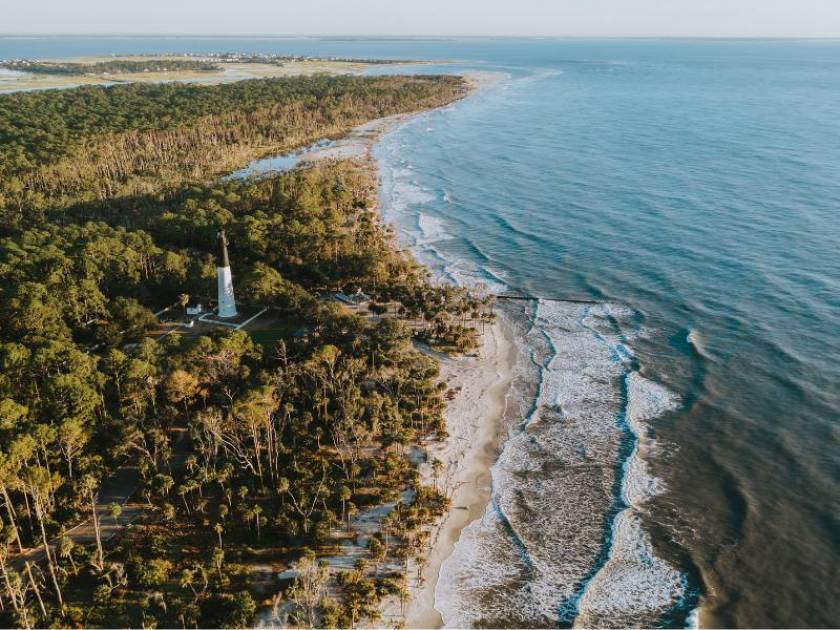
There is a reason why Hunting Island is the most visited state park in South Carolina: from its sandy beaches to its dense maritime forest, it exemplifies the best of what the famous South Carolina Coast has to offer. Hunting Island is a 5,000-acre barrier island located in the Lowcountry near the beautiful historic town of Beaufort.
Originally built in the 1930s, Hunting Island is one of sixteen South Carolina Parks developed by the Civilian Conservation Corps (CCC). It is one of the last barrier islands that remains undeveloped. In fact, the landscape of the park remains natural as rangers have opted to leave the beach completely untouched, allowing fallen trees and washed up logs to remain where they land until they decompose or are carried out to sea.
So what do you need to know before your visit to Hunting Island State Park? Read on!
Where Is Hunting Island State Park?
Hunting Island State Park is situated along the southeastern coast of South Carolina about fifteen miles from the small city of Beaufort. Its location between Harbor Island and Fripp Island is telling of the type of area you’ll be exploring: one with several beautiful barrier islands to explore including Hunting Island.
Hours and Admission
Hunting Island State Park is open from 6AM to 6PM every day except during Daylight Saving Time when the hours are extended to 9PM. The best time to visit depends on what you want to see and do. If you want to see wildlife, the ideal time to go is early in the morning or into the evening hours; other than that, any time of day is a good time to visit. Make sure to set out early if you plan to do a longer hike.
The office and visitor center are open from 9AM to 9PM on weekdays and 11AM to 5PM on weekends.
Admission:
- $8/adults
- $5/seniors
- $4/child age 6-15
- Free for children 5 and younger
When Is The Best Time Of Year To Visit Hunting Island State Park?
You can visit the park any time of year but, basically, it will depend on what you plan on doing there that will decide the best time for you to go. If swimming, kayaking, or sailing are your thing, the end of spring to the first weeks of fall would be ideal with the summer months of course being the warmest, but also the most packed.
If hiking and fishing are your activities, then your best time might be spring and fall when the temperatures are cooler. Also, this tends to be the time of year when there are less people, so you have a chance that the trails and fishing spots will be almost empty. If you visit during the winter, it’s even likely you’ll have much of the park to yourself.
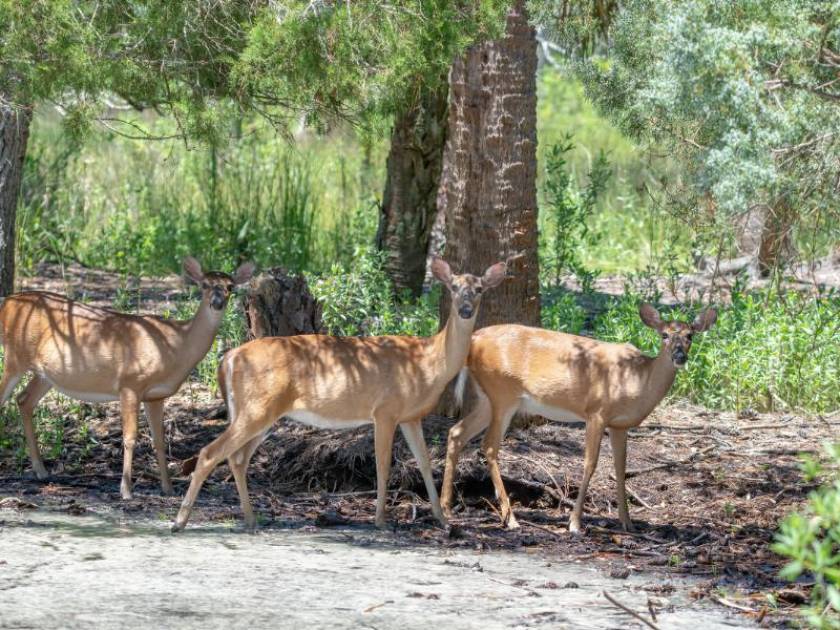
Things To Do In Hunting Island State Park
Visit the Hunting Island Visitor Center and Nature Center
Visitors should keep an eye out for wildlife from the moment they enter the park. A drive though the maritime forest leads to the visitor’s center that has information about all the island has to offer, including trail maps. Several small ponds lie between the parking lot and the visitor’s center where it is common to see the scaly nose or the beady eyes of an American alligator staring up through dense patches of duckweed. The visitor center also has a nice outdoor deck for viewing nature and wildlife.
Another gem in the park is the nature center located near a long fishing pier that overlooks Fripp inlet. Rangers here show guests live animals, skulls, bones, and other animal remains. Taxidermy animals are also displayed for educational purposes. Stroll out along the fishing pier where locals and visitors alike often go crabbing and fishing. The nature center will even loan out rods and reels to visitors. Ospreys and pelicans frequently soar overhead as well.
There are also daily public educational programs from Memorial Day to Labor Day and there are several other programs offered including kayaking trips in the tidal lagoon. Be sure to check the programs and events page for details.
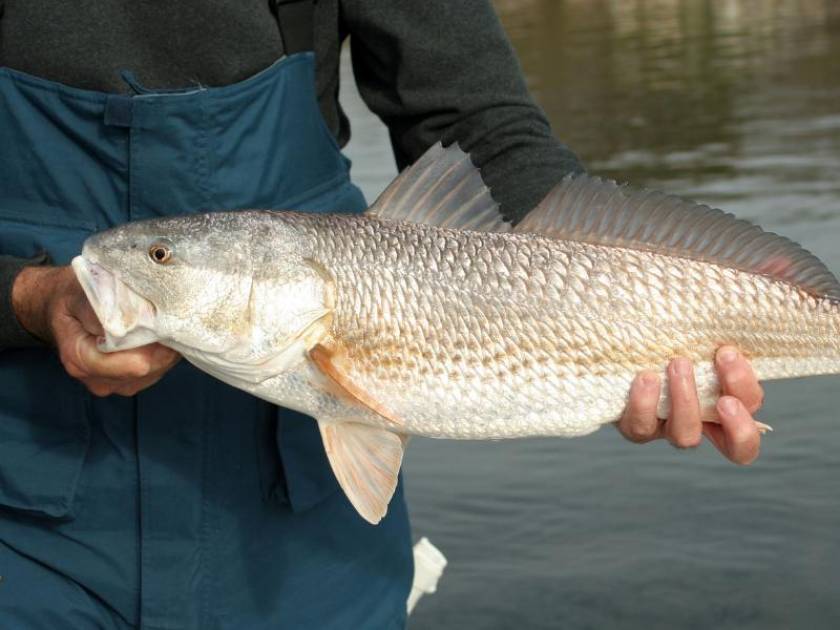
Fish from the Hunting Island Fishing Pier
As noted, the fishing pier is right next to the Nature Center. It was destroyed in 2016’s Hurricane Mathew, but was reopened in 2021 after being completely rebuilt.
The fishing pier extends 950 feet into Fripp Inlet.
If you want to fish on the pier you do not need to have a fishing license. However, if you want to fish anywhere else in the park you will need to have a South Carolina saltwater fishing license. Bait, equipment, and other supplies can be purchased at the park store located in the campground
The fishing pier additionally overlooks a marsh where animals commonly search for food. Lucky guests may see a racoon strolling through the cordgrass or a great white egret standing out against the bright green background.
Whether you want to do some fishing or just watch for seabirds and dolphins and enjoy the sea breeze, the fishing pier is a great place to take a break.
Go for a Walk on the Marsh Boardwalk
The boardwalk extends across the marsh tidal flats of the park to a small nature viewing platform. You can find the boardwalk on the west side of the park on Highway 21. There are self-explanatory signs to find the boardwalk.
The marsh boardwalk is considered one of the best places to view a sunset from within the park. It’s a great place to enjoy the salt marsh without getting your wet feet. In this area marsh birds are plentiful including great white egrets, great blue herons, and wood storks, as well as clapper rails and marsh wrens.
The boardwalk is probably the most serene and peaceful spot in the entire island.
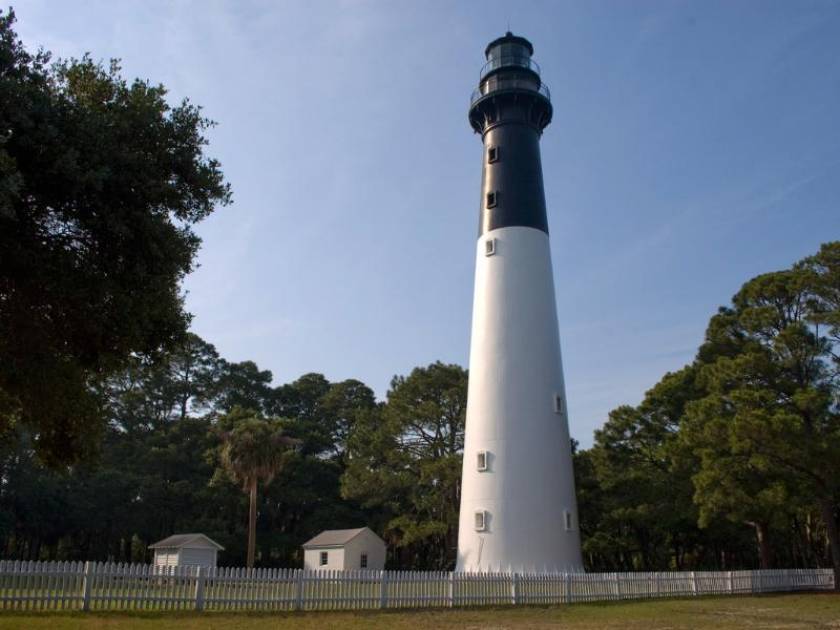
Climb the Lighthouse
Originally built in 1859, Confederate forces destroyed the structure to ensure the Union would not be liable to use it against them.
It was rebuilt in 1875 using interchangeable cast iron sections so it could be dismantled and moved when threatened by beach erosion. Since its construction, it has already been moved once, 1.3 miles inward in 1889.
Decommissioned in 1930, this iconic black and white colored, blocked lighthouse retains a functional light in its tower. When opened, it is well worth the extra fee ($2) to climb the 167 iron steps to the 130-foot observation deck where you can enjoy a breathtaking view of the Atlantic ocean and surrounding maritime forest.
Due to safety concerns, it is currently closed to tours until repairs can be made. However, visitors are welcome to tour several buildings on the site featuring exhibits and docents are on hand to give more information about the lighthouse.
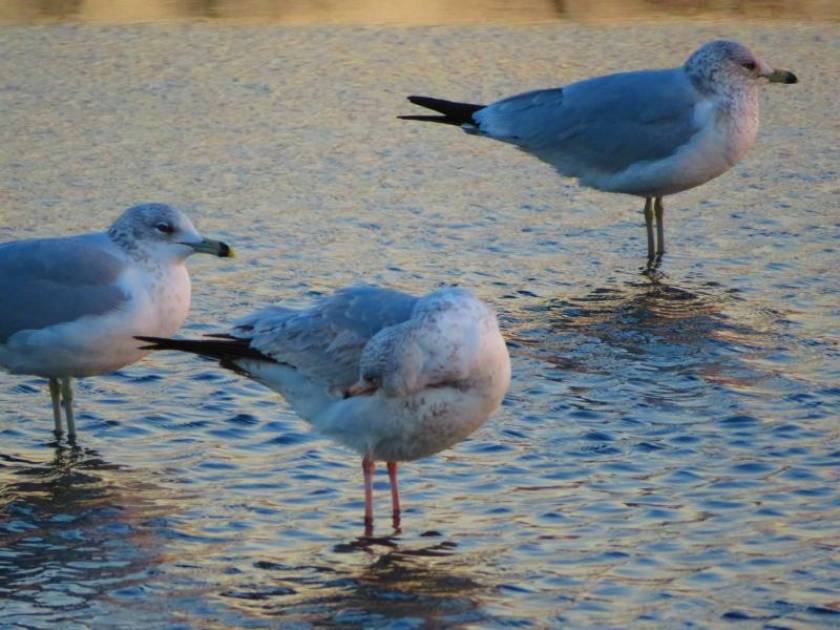
Enjoy the Saltwater Lagoon
Known as the “quiet side of the beach” the Hunting Island lagoon is the perfect spot for those who want to get away from the Atlantic surf and still be near the water.
The lagoon is home to hundreds of birds and other wildlife species including racoon, deer, blue heron, egret, pelican, sandpiper, and kingfisher. Fishing, photography, and lots of kayaking are daily lagoon activities.
The maritime forests and marsh are so dense around the lagoon that it has been used for a number of Vietnam War scenes in films such as Forrest Gump, Rules of Engagement and Full Metal Jacket.
View the South Beach Boneyard
With Hunting Island being a barrier island, erosion has taken a toll on the beach for a very long time. This erosion with the encroachment of saltwater has cut into the maritime forest on the island bringing down trees and producing a “graveyard” of sorts. Located at the south end of the island, it’s a stretch of beach that will have you roaming through and around fallen pine and palmetto trees, many with their roots exposed creating a moody, almost eerie, scene.
Explore the Maritime Forest
One of the most spectacular features of Hunting Island State Park is the maritime forest. While most South Carolina maritime forests have smaller wind-battered palmettos, Hunting Island is unique in the size of the trees that abut the beach. Full size palmettos greet the sand in thick groves, a result of the intense erosion that takes place here. It is amazing to see the forest suddenly cut off exposing the fine, white sand beaches. Boardwalks meander through the trees and guide visitors to the beach through this forest. If you are looking for a longer path, the park offers additional trails for biking or hiking through the forest.
Don’t Miss the Boulders at the Groens
Boulders were placed at points along the beach the last time that Hunting Island went through a renourishment project. Once just rocks, they are now barnacle laden and teeming with life. At low tide, crabs and small fish that live in the rocks get trapped and it can be just like enjoying a home aquarium.
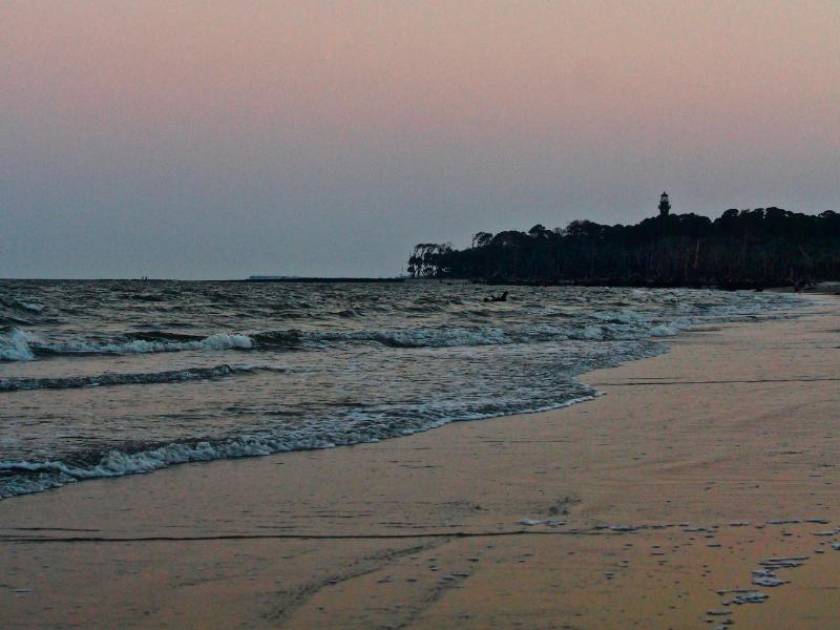
Marvel at the Beaches
Of course the beaches on Hunting Island are stunning. The sand is superfine and ivory in color, and the water is among the clearest in South Carolina. Five miles of beaches stretch around the Island, perfect for sunbathing or strolling. Birds such as piping plovers run along the shore and pelicans soar above. For those who want to venture further out into the ocean, the park also has a boat ramp.
Hike the Trails
The state park offers an extensive trail system, totaling more than eight miles in length. The trails are all interconnected allowing visitors to enjoy a path as long or short as they desire. Trails traverse through the forest or marsh, or lead up the beach, showing the diverse topography of Hunting Island.
Here is a trail overview of the Hunting Island Trails:
- Diamondback Rattlesnake Trail – This trail is 1.9 miles in length and is geared for experienced walkers and mountain bikers; it is a bit difficult in spots. Only tackle this one if you’re fit and used to hiking strenuous terrain.
- Magnolia Forest Trail – This is an ideal trail if you’re traveling with children as it is easy and, at only 1.2 miles, it’ll only take a short time to do. From the campground you’ll walk through a hilly area full of beautiful magnolia trees.
- Maritime Forest Trail – This trail is 2 miles long and very easy. It will take you deep into the maritime forest where you will encounter dense vegetation that provides a protected habitat for many animals including deer, racoons, owls, hawks, and squirrels.
- Lagoon Trail – This 1.4-mile trail winds along the lagoon. It leads you through the maritime forest while providing scenic views of the lagoon and the various wildlife habitats.
- Nature Center Scenic Trail – This is an easy hike at 0.7 miles, but if you decide you want to keep hiking this trail connects to some of the park’s other popular trails. Make sure to cross the pedestrian bridge to gain access to the two trails on Little Hunting Island. Enjoy the ever changing views of a wild barrier island.
- Marsh Boardwalk Crossover Trail – A connection trail of 0.3 miles that interests the Lagoon Trail, Maritime Forest Trail, and Diamondback Rattlesnake Trail to provide a path leading to the Marsh Boardwalk Trail.
- Marsh Boardwalk Trail – Designated as a Nature Trail this 0.25-mile wooden boardwalk is great for observing life in the marsh. (See our description earlier in the article)
- Palmetto Pass Trail – This easy 0.2-mile trail offers easy access to the Maritime Forest and Diamondback Rattlesnake trails.
- Pine Pass Trail – This easy 0.2-mile trail connects the Lagoon Trail with the Maritime Forest Trail.
Where to Eat at Hunting Island State Park
There are no restaurants in Hunting Island State Park. That means you’ll have to drive to nearby Beaufort (30 minutes) or you’ll need to pack a lunch.
When enjoying a full day in the park, packing a lunch is best. There are plenty of picnic facilities in scenic spots to enjoy a meal and take in the beauty around you. If you want to go hog with your picnic, you can rent an entire picnic shelter for $100-200 a day. The shelters have electricity, power outlets, and lighting. If a shelter is not reserved, visitors may use it on a first come first served basis at no charge.
However, if you prefer to sit down at a restaurant check out our post on The Best Restaurants in Beaufort, South Carolina in our Food+Drink section
Where to Stay at Hunting Island State Park
For those who want more than a day trip at Hunting Island, there are lodging and camping opportunities available on the island.
While the majority of the cabins have been lost to erosion, the state park still has one available for rent which is just steps away from the beach and offers great views of the lighthouse.
The cabin includes linens, basic cooking and eating utensils, satellite television, free WiFi, microwave oven, dishwasher, washer and dryer, coffee maker, central air and heat, outside grill and picnic table. It also includes a screened porch. Pets are not permitted in the cabin or cabin area.
The cabin has a minimum stay of two nights with some dates having a longer minimum. Rates vary by season and demand and are subject to change. The cabin does book out well in advance so if you are wanting to stay in the cabin, you will need to plan ahead.
Most visitors, however, choose to sleep in the great outdoors at one of the 181 campsites (102 are RV campsites with electricity and water available) adjacent to the Atlantic Ocean.
The camping rates vary by season and demand. You can check rates and make reservations online. Again, the park recommends making reservations a few months in advance as spots book quickly during peak times..
Hunting Island Hotels
There are not any hotels in Hunting Island State Park. There are a few options on Fripp Island as well as Harbor Island. Beaufort, as noted, is not too far of a drive and there are lots of options there.
Pets in Hunting Island State Park
Pets are not allowed in the cabin or cabin area, on the pier, inside the lighthouse area, or on the tip of the North Beach. Dogs are allowed in most other outdoor places if they are on a leash and do not harass the wildlife.
Accessibility
There are wheelchairs available to use free of change at the park store. The Hunting Island State Park beach has easy access by wheelchair from the parking lot.
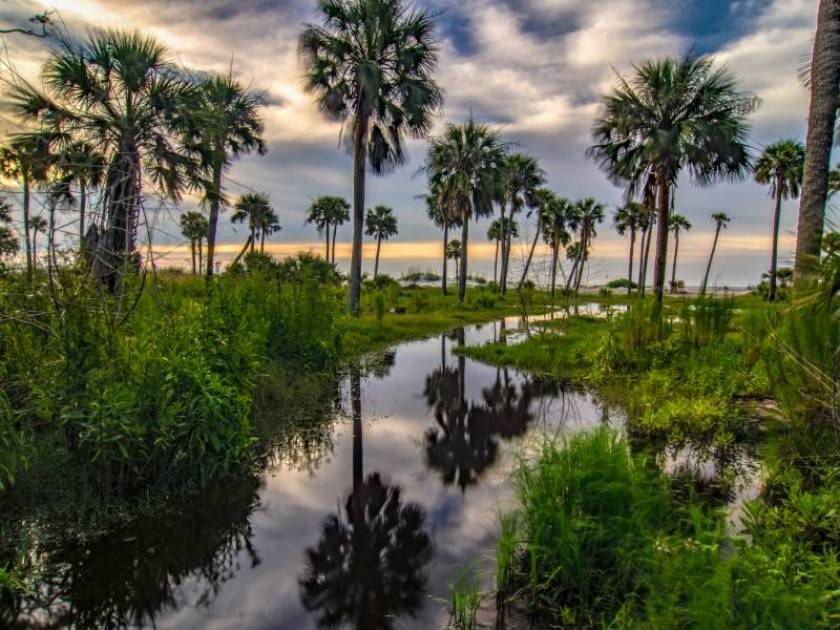
Things to Do Near Hunting Island State Park
Visit Beaufort
Beaufort is a coastal town rich in history, wonderful food, unique lodging, plentiful art galleries and antique shops, and a Bayside park.
Take a Trip to St. Phillips Island
Purchased by media mogul Ted Turner in 1979, this barrier island has managed to retain its wild splendor thanks to Turner’s conservation efforts and his partnership with The Nature Conservancy.
Turner sold St. Phillips Island to South Carolina State Parks in 2017 and today it is managed by Hunting Island State Park located 5 miles northeast of the secluded island. To allow the public to enjoy the island (which is accessible only by boat) the parks department teamed up with Coastal Expeditions to offer ecotours of St. Phillips.
Departing from St. Helena Island, the St. Phillips Ferry starts with a 30-minute boat ride along the Story River led by a naturalist with extensive knowledge of the fragile coastal environment. The trip continues with a 3.5-mile ride to the St. Phillips dock on the backside of the island by the beach located near Turner’s former home. It’s not unusual to spot alligators, egrets, and other wildlife during this ride.
Once at the tram stop, you are free to walk the beach and explore the island on your own on some 4 miles of trails Turner carefully carved through the forest. Traveling the length of the island you’ll enjoy spectacular views of the salt marsh, Trenchards Inlet, and a “boneyard beach” scattered with the weather beaten remnants of trees.
The five bedroom Turner House, now available for rent ($12,000-20,000 for 5 days, includes transportation and grocery credit) is closed to the public. However, if it is unoccupied during your visit you are welcome to walk to the house located about a quarter mile from the tram stop to take in the view from its fishing pier. Picnic tables are available in the area to enjoy the packed lunch you’re encouraged to bring on the day.
The St. Phillips Island Ferry departs from Coastal Expeditions St. Helena Island campus located at 1928 Sea Island Parkway (843-884-7684).
For booking information concerning the Turner House contact the reservation desk at (803) 904-6220.
Final Thought
Just Go! Spend a day or more at Hunting Island and you’ll quickly understand why this secluded Lowcountry barrier island is South Carolina’s most popular state park.